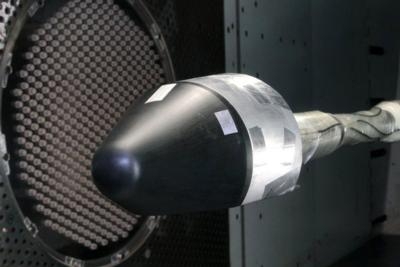Sat, Apr 28, 2012
Wind Tunnel Experiments Validate Aerodynamic Qualities For Re-Entry
Blue Origin, which normally shuns the attention of the media, said Thursday it has successfully tested the design of its next-generation Space Vehicle, completing a series of wind tunnel tests to refine the aerodynamic characteristics of the spacecraft’s unique biconic shape. The tests were carried out as part of Blue Origin’s partnership with NASA under the agency’s Commercial Crew Development (CCDev) program. Blue Origin is designing the Space Vehicle to provide safe, affordable transport of up to seven astronauts to low-Earth orbit and the International Space Station.

“Our Space Vehicle’s innovative biconic shape provides greater cross-range and interior volume than traditional capsules without the weight penalty of winged spacecraft,” stated Rob Meyerson, president and program manager of Blue Origin. “This is just one of the vehicle’s many features that enhance the safety and affordability of human spaceflight, a goal we share with NASA.”
The wind tunnel tests validated Blue Origin’s analysis of the Space Vehicle’s aerodynamics during descent through the atmosphere and the ability to change its flight path, increasing the number of available landing opportunities each day and enhancing the vehicle’s emergency return capability. More than 180 tests were conducted over the past several weeks at Lockheed Martin’s High Speed Wind Tunnel Facility in Dallas.

Under CCDev, Blue Origin is maturing the design of the Space Vehicle, including its aerodynamic characteristics, culminating in a System Requirements Review in May of this year. Blue Origin will conduct tests of its pusher escape system later this year, demonstrating the ability to control the flight path of a subscale crew capsule using an innovative thrust vector control system. Also under CCDev, Blue Origin is conducting tests of the thrust chamber assembly (TCA) for the BE 3 100,000-lbf liquid oxygen, liquid hydrogen rocket engine, which was recently installed on the E 1 complex test stand at NASA’s Stennis Space Center.
Blue Origin is backed financially by Amazon.com founder Jeff Bezos. (Images provided by Blue Origin)
More News
A Puff Of Smoke Came Out From The Top Of The Engine Cowling Followed By A Total Loss Of Engine Power On May 9, 2025, about 1020 mountain daylight time, an experimental amateur-buil>[...]
From 2022 (YouTube Edition): Jenny, I’ve Got Your Number... Among the magnificent antique aircraft on display at EAA’s AirVenture 2022 was a 1918 Curtiss Jenny painstak>[...]
Very High Frequency (VHF) The frequency band between 30 and 300 MHz. Portions of this band, 108 to 118 MHz, are used for certain NAVAIDs; 118 to 136 MHz are used for civil air/grou>[...]
“From approximately November 2021 through January 2022, Britton-Harr, acting on behalf of AeroVanti, entered into lease-purchase agreements for five Piaggio-manufactured airc>[...]
Microburst A small downburst with outbursts of damaging winds extending 2.5 miles or less. In spite of its small horizontal scale, an intense microburst could induce wind speeds as>[...]
 NTSB Prelim: Lee Aviation LLC JA30 SuperStol
NTSB Prelim: Lee Aviation LLC JA30 SuperStol Classic Aero-TV: Curtiss Jenny Build Wows AirVenture Crowds
Classic Aero-TV: Curtiss Jenny Build Wows AirVenture Crowds ANN's Daily Aero-Term (05.30.25): Very High Frequency (VHF)
ANN's Daily Aero-Term (05.30.25): Very High Frequency (VHF) Aero-News: Quote of the Day (05.30.25)
Aero-News: Quote of the Day (05.30.25) ANN's Daily Aero-Term (05.31.25): Microburst
ANN's Daily Aero-Term (05.31.25): Microburst




